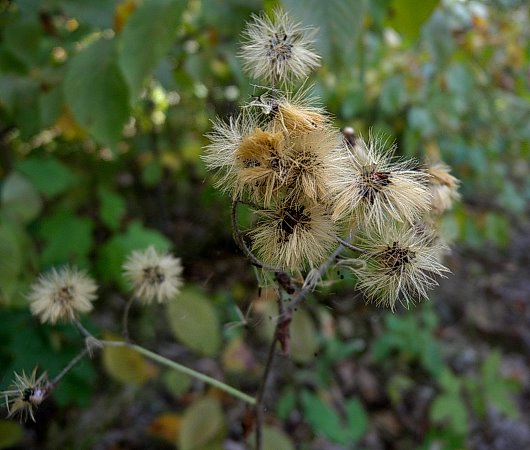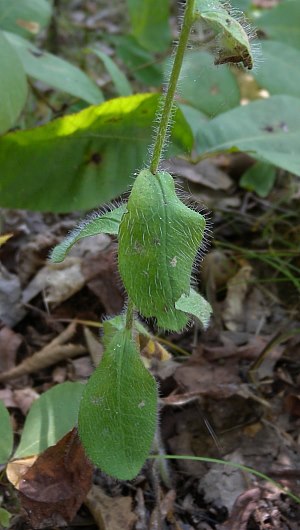
The central stem terminates in an elongated panicle of flowerheads up to 1' long and ½' across. Individual flowerheads are ½-¾" across, consisting of 30-60 yellow ray florets and no disk florets. Around the base of each flowerhead, 12-20 floral bracts (phyllaries) are arranged in a single series. Individual floral bracts are light green, linear in shape, and often glandular-hairy. The branches of the inflorescence are light green to dull purple and glandular-hairy; there are often a small leafy bracts (less than 1" in length) where these branches divide. The glandular hairs along the branches of the inflorescence and the floral bracts of the flowerheads are often black. The blooming period occurs from late summer to early fall for about 3-4 weeks. The florets are self-fertile in the absence of cross-pollination. The florets are replaced by achenes with tufts of tawny hair. Individual mature achenes are about 1/8" (3 mm.) long, narrowly cylindrical in shape, truncate at the apex, and dark brown. The root system is fibrous and rhizomatous; older plants may have a short underground caudex. Small colonies of plants are formed occasionally by the spreading rhizomes. A small rosette of basal leaves may be present during the winter after the flowering stalk with alternate leaves dies down.
 Cultivation:
The preference is full sun to light shade, mesic to dry-mesic
conditions, and soil containing loam, sand, or rocky material. The size
of individual plants and the abundance of their flowerheads is
highly variable.
Cultivation:
The preference is full sun to light shade, mesic to dry-mesic
conditions, and soil containing loam, sand, or rocky material. The size
of individual plants and the abundance of their flowerheads is
highly variable.Range & Habitat: The native Rough Hawkweed is occasional in most areas of Illinois (see Distribution Map). Habitats include rocky upland woodlands, bluffs, wooded slopes, woodland openings, savannas and sandy savannas, partially shaded ledges, woodland borders, and sandy roadsides. This wildflower benefits from occasional disturbance to reduce competition from woody vines, shrubs, and trees.
Faunal Associations: Surprisingly little information is available for hawkweeds (Hieracium spp.) about their floral-faunal relationships. The flowerheads are probably cross-pollinated by long-tongued bees and other insects; both nectar and pollen are available as floral rewards to such visitors. Hawkweeds are suspected host plants for the caterpillars of Schinia bina (Bina Flower Moth). The seeds or leaves are occasionally eaten by the Wild Turkey and Ruffed Grouse, while the foliage is browsed sparingly by the Cottontail Rabbit and White-Tailed Deer (Martin et al., 1951/1961). However, the bitter white latex and hairiness of the foliage does not make this species a preferred source of food for such animals.
Photographic Location: A deciduous woodland near an artificial lake at a state park in east-central Illinois.
Comments: This is one of several native hawkweeds (Hieracium spp.) in Illinois that have unbranched leafy stems and yellow flowerheads. Generally, they prefer semi-shaded wooded areas that are sandy or rocky, although Rough Hawkweed also occurs in woodlands with fertile loam. It is very similar in appearance to Hieracium gronovii (Gronovius' Hawkweed), but the latter species has spindle-shaped achenes with tapered upper tips (rather than truncate upper tips), relatively fewer florets per flowerhead (about 20-40), and leaves that are located toward the base of its central stem. Another similar species, Hieracium canadense (Canada Hawkweed), has larger flowerheads (¾-1¼" across) with more florets per flowerhead (40-100), inflorescence branches that are short-pubescent (rather than glandular-hairy), and more leaves along each central stem (often 12 or more). There are some hawkweeds that have been introduced from Europe, but their leaves are arranged in basal rosettes during the blooming period, unlike the native hawkweed species.